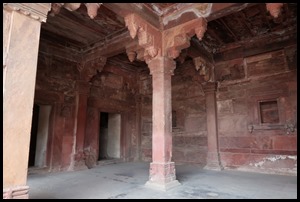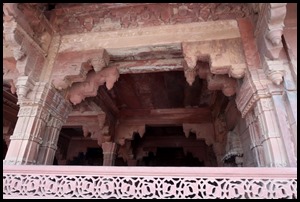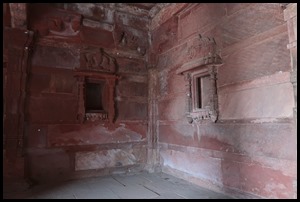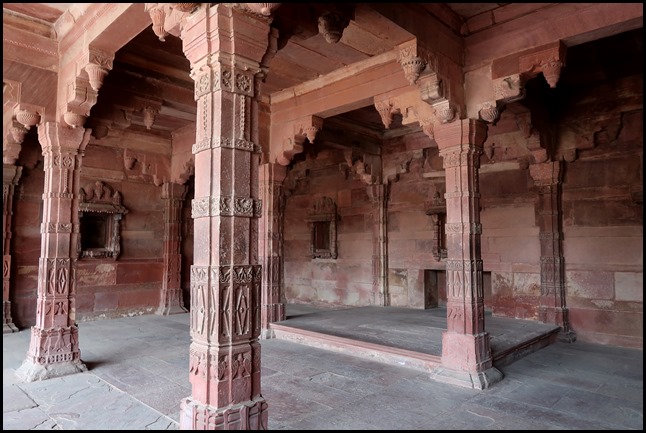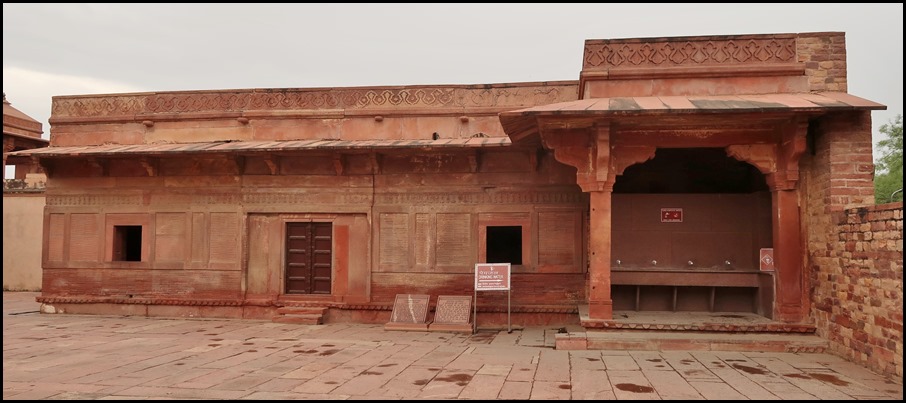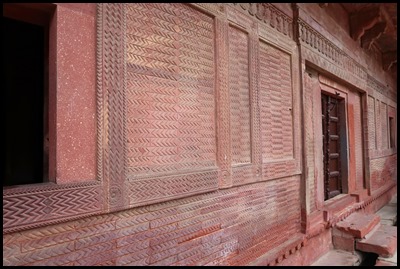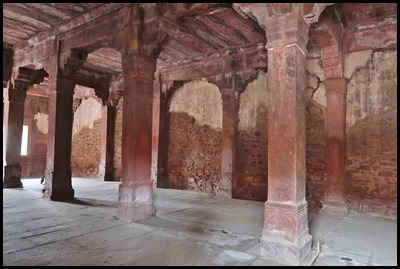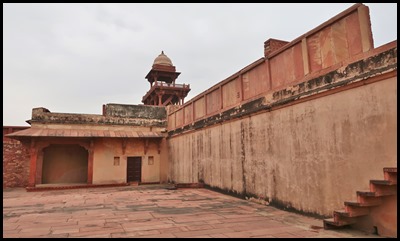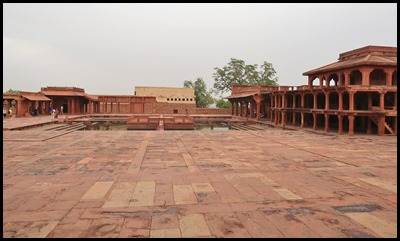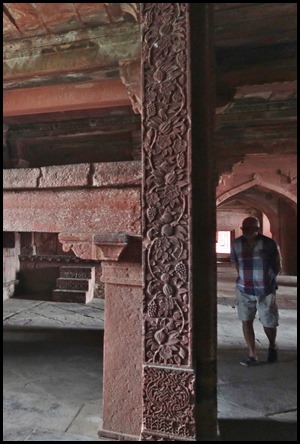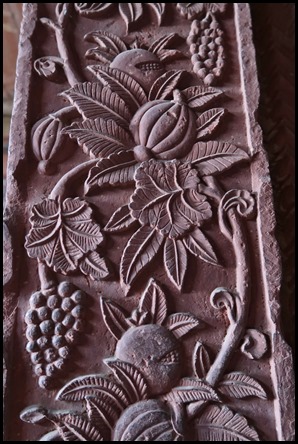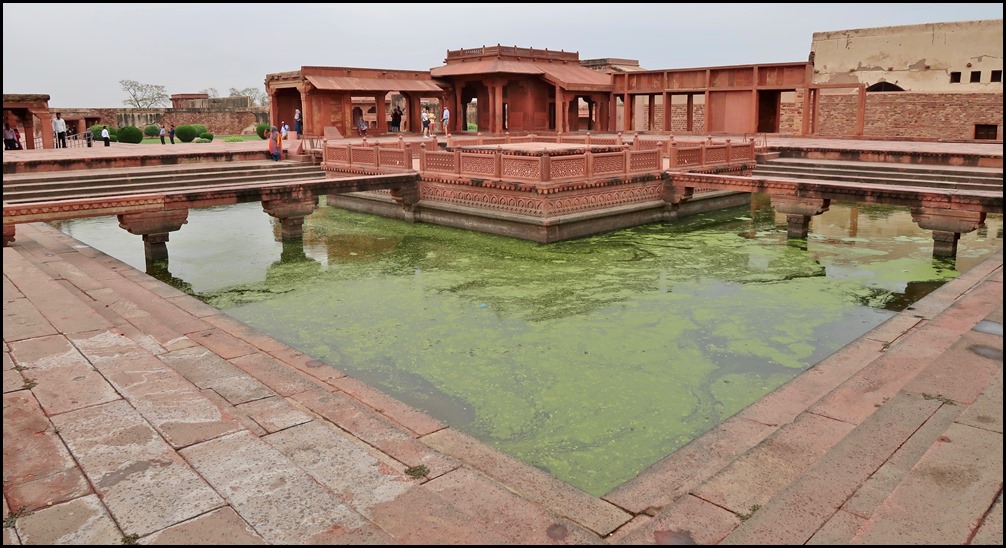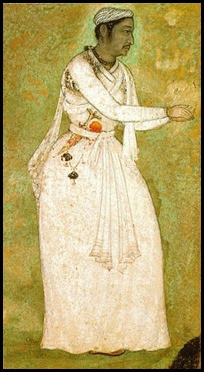Fatehpur Palaces 1

|
Fatehpur Sikri
Palaces – Part One 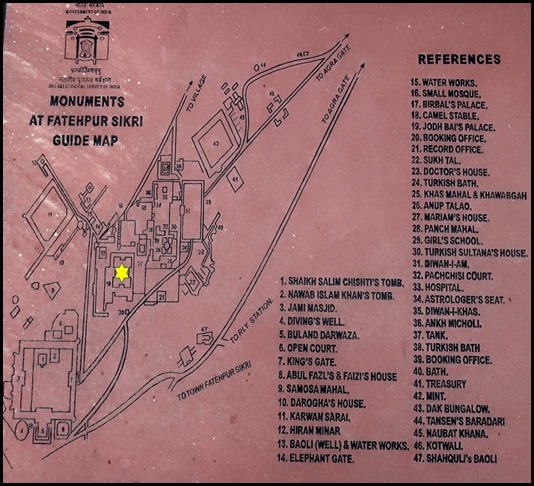 We
left the fort and crossed quite a big area passing a map of
the whole site. The fort is bottom left and were heading for where I have
put a yellow star.
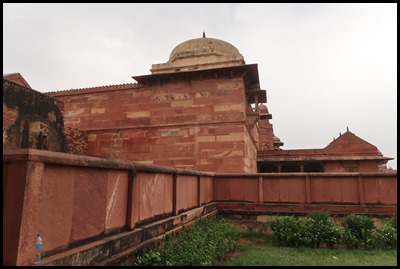  We passed a sturdy
wall, entered a small, easily defendable gate and looked up at the first palace in the complex.
 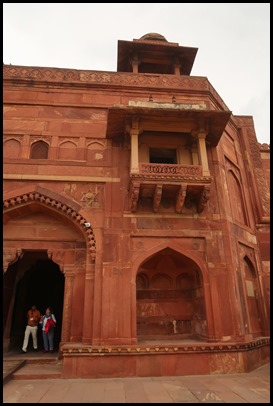 The stone information tablet read: The
Shabistal-I-Iqbal (Jodhbai’s Palace). This imposing
palace comprising the principal Haramsara of Akbar has been wrongly ascribed to
Jodh Bai who was nothing to do with Sikri. It is the most impressive of all the
royal edifices.
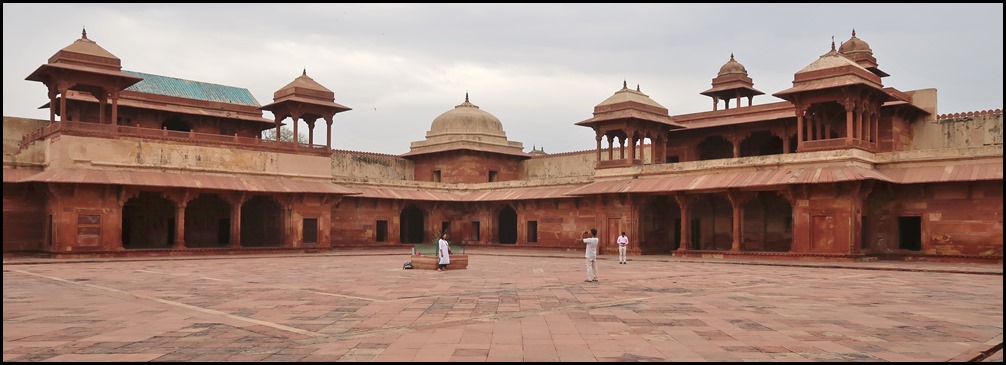 It consists of a large open plan
quadrangle on the sides of which are suites of storied blocks in the centre and
corners to break the skyline, the central block on the east forms a vestibule to
the main entrance of the building and on the west is a small shrine supported on
richly carved pillars. The shrine has niches for keeping images of Hindi dieties
and a platform for the principal deity. The azure-blue glazed tiles of the roof
of this palace are also noteworthy. It was probably built between A.D. 1570 and
1574. Each side of the quadrangle is the summer
palace and opposite, the one used in the winter.
I found this write-up on the internet :Mariam-uz-Zamani Begum, also known as Heer Kunwari,
Hira Kunwari, Harka Bai or Jodha Bai was a Hindi Empress of the Mughal Empire.
She was the first chief Rajput wife of Emperor Akbar (though Akbar already had
two other Chief Mughal wives (one Muslim and one Christian) and many other wives
before his marriage to Rajput Princess Heer Kunwari), and the mother of the next
Mughal Emperor, Jahangir. She was also the grandmother of the following Mughal
Emperor Shah Jahan.
Mariam-Uz-Zamani was referred to as the Queen Mother of Hindustan, during the reign of the Great Mughal, Emperor Akbar and also during her son Emperor Jahangir's reign. She was the longest serving Hindu Mughal Empress. Her tenure, from the 6th of February 1562 to the 27th of October 1605, is that of over 43 years. Her marriage to Akbar led to a gradual shift in his religious and social policy. Akbar's marriage with Rajkumari Heer Kunwari was a very important event in Mughal history. She is widely regarded in modern Indian history as exemplifying Akbar's and the Mughal's tolerance of religious differences and their inclusive policies within an expanding multi-ethnic and multi-denominational empire. The largest of all the palaces (231’8” by 215’), it is a rectangular block with one single gateway on the eastern side, which was protected by guard rooms having triangular ceiling and other apartments. Several Hindu motifs have been used in the building, which confirms that occupant of the building was a Hindu lady. Here architectural elements of Gujarat, Mandu and Gwalior are blended with traditional Islamic designs. Its blue-tiled roof is the only splash of colour in Fatehpur Sikri.
Features, rooms and the royal bed.
The Haramsara of Fices (Jodhbai's Kitchen). This richly carved structure is popularly designed as Jodh Bai's Kitchen. But it may have been an annex of the haramsara, the cloisters adjoining it have been survived. Its sloping roof has been subsequently replaced by a flat one.
The outer walls are carved with floral and geometric patterns and bands of Jhumkas (Ear-Ornaments) and brick-like pellets of stone (Mat design). This building is noteworthy for its refined surface ornamentations. A look in the window at the inside.
A short bimble brought us to The Sunahra Makan (Maryam's Mansion). This residential building of the haramsara, popularly known as Maryam-Ki-Kothi (Maryam's Mansion) was profusely embellished with paintings and hence was designated as sunahra makan. It has four rooms, an oblong one running north-south and three others from which a stair-case leads to the flat roof surmounted by an open pavilion which is supported on eight square pillars and was used for sleeping purposes in summer night. The brackets are adorned with sculptures on the north side is carved Rama attended by Hanuman. While other brackets show a band of Kirti mukhas (Lion-Heads) and a pair of geese and elephants. The Building also has mural paintings, while Persian inscriptions are painted on the beams of the verandah containing verses of faizi, the poet laureate of Akbar's court.
We passed what we thought to be maids or guards quarters, stepped through a gate to find ourselves in a massive courtyard. Just the bit ahead of us was huge and spread a long way to the left surrounded by more buildings. Ahead a pool, to the left another of the queens palaces and to the right Akbar’s nest. Well he would need a quiet refuge away from all those women...... Mmmm, steady.......  Khwabgah Complex is also called The Dream Palace was the personal palace of the Emperor.
This double storied building is built with red sandstone. The ground floor is
very simple, while the first floor is excellently ornamented.
The building is one of the most well-planned buildings of Fatehpur Sikri. It has two rooms on the ground floor and a well-ventilated pavilion on the first floor. The rooms on lower floor were probably used as a library and a dining hall. It is believed that the library or Kutub Khana of Akbar had more than 25,000 manuscripts along with his important official documents. This complex was also connected to the offices (Dafter Khana) of the royal complex.
The bedroom (bed set high above the ground – maybe for safety or simply to
catch the breeze) known as Khilwatkada-i-Khas was surrounded by a
pillared verandah with a stone-tiled sloping roof. The room is beautifully
decorated and has carved panels and beautiful mural paintings depicting scenes
from the Mughal court on the walls. The walls also have some Persian
inscriptions praising the beauty of the palace and relating it to heaven. It was
connected to the imperial harem and Panch Mahal through an enclosed passage.
There is a big window in one portion of the lower floor that is known as
Jharokha. The Emperor showed himself daily to the general public through this
Jharokha. Abdar Khana is located to the northern side of Khwabgah. This is a
double storied building which has deep shelves with arched screens for storing
tropical fruits like melons, grapes and mangoes and
water jars for the king.
Abu'l-Fath Jalal-ud-din Muhammad Akbar was born in October 1542, popularly known as Akbar I or Akbar the Great. He was the third Mughal emperor who reigned from 1556 to 1605. He succeeded his father, Humayun, under a regent, Bairam Khan, who helped the young emperor expand and consolidate Mughal domains in India. A strong personality and a successful general, Akbar gradually enlarged the Mughal Empire to include nearly all of the Indian Subcontinent north of the Godavari River. His power and influence, however, extended over the entire country because of Mughal military, political, cultural, and economic dominance. Akbar's reign significantly influenced the course of Indian history. During his rule, the Mughal empire tripled in size and wealth. He created a powerful military system and instituted effective political and social reforms. By abolishing the sectarian tax on non-Muslims and appointing them to high civil and military posts, he was the first Mughal ruler to win the trust and loyalty of the native subjects. He had Sanskrit literature translated, participated in native festivals, realising that a stable empire depended on the co-operation and good-will of his subjects. Thus, the foundations for a multicultural empire under Mughal rule were laid during his reign. Akbar married twelve times, his ‘favourite’ three wives were Hindu, Christian and Muslim, their palaces we saw today. The rest were political (daughter of the ruler of Khandesh, a daughter of the ruler of Bikanir, the daughter of Sultan Mahmud of Bhakkar, the daughter of Arab Shah, the daughter of Shams Chak, a Kashmiri and the daughter of Qazi Isa) or for family-linking advancements (two cousins). Akbar was succeeded as emperor by his son, Prince Salim, later known as Jahanqir. On the 3rd of October 1605, Akbar fell ill with an attack of dysentery from which he never recovered. He is believed to have died on or about the 27th of October 1605, after which his body was buried in a mausoleum in Sikandra, Agra.
Tansen Chabutra Pool or The Peerless Pool also called Kapur Talao by Jahangir, is a pretty tank. It is 29.10 meters square and its center is a balustraded platform approached by four causeways supported on short stone pillars. Completed in A.D 1575, it was intended for imperial amusement and private functions. Concerts given by Tansen were the most popular.
Tansen (c. 1500 – 1586), was a prominent figure of North Indian (Hindustani) classical music. Born into a Hindu family, he learned and perfected his art in the northwest region of modern Madhya Pradesh. He began his career and spent most of his adult life in the court and patronage of the Hindu king of Rewa, Raja Ramchandra Singh (r.1555–1592), where Tansen's musical abilities and studies gained widespread fame. This reputation brought him to the attention of the Mughal Emperor Akbar, who sent messengers to Raja Ramchandra Singh, requesting Tansen to join the musicians at the Mughal court. Tansen did not want to go, but Raja Ramchandra Singh encouraged him to gain a wider audience, and sent him along with gifts to Akbar. In 1562, about the age of 60, the Vaishnava musician Tansen joined the Akbar court, and his performances became a subject of many court historians. Numerous legends have been written about Tansen, mixing facts and fiction, and the historicity of these stories is doubtful. Akbar considered him as a Navaratnas (nine jewels), and gave him the title Mian, an honorific, meaning learned man. Tansen was a composer, musician and vocalist, to whom a large number of compositions have been attributed in northern regions of the Indian subcontinent. He was also an instrumentalist who popularized and improved musical instruments. He is among the most influential personalities in North Indian tradition of Indian classical music, called Hindustani. His 16th century studies in music and compositions inspired many, and he is considered by numerous North Indian gharana (regional music schools) as their lineage founder. Tansen is remembered for his epic Dhrupad compositions, creating several new ragas, as well as for writing two classic books on music Sri Ganesh Stotra and Sangita Sara.
CONTINUED
|

